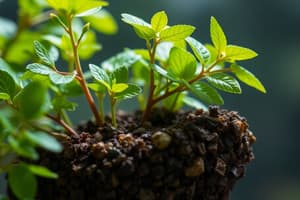Podcast
Questions and Answers
What is the primary purpose of photosynthesis in plants?
What is the primary purpose of photosynthesis in plants?
- To capture energy from sunlight and produce glucose (correct)
- To break down glucose and release energy
- To utilize oxygen to perform cellular respiration
- To convert carbon dioxide into oxygen gas without using sunlight
Which of the following is a product of cellular respiration?
Which of the following is a product of cellular respiration?
- Glucose
- Oxygen gas
- ATP (energy) (correct)
- Sunlight energy
Which statement accurately represents the relationship between photosynthesis and cellular respiration?
Which statement accurately represents the relationship between photosynthesis and cellular respiration?
- Photosynthesis occurs only in animals while respiration occurs in plants.
- Photosynthesis and respiration are the same process.
- Photosynthesis consumes CO2 and produces O2, while respiration consumes O2 and produces CO2. (correct)
- Both processes occur only in terrestrial ecosystems.
What role does decomposition play in the carbon cycle?
What role does decomposition play in the carbon cycle?
What chemical equation represents photosynthesis?
What chemical equation represents photosynthesis?
Which factor is essential for cellular respiration to occur in aerobic organisms?
Which factor is essential for cellular respiration to occur in aerobic organisms?
What is the first law of thermodynamics in relation to metabolism?
What is the first law of thermodynamics in relation to metabolism?
Which process is NOT part of the carbon cycle?
Which process is NOT part of the carbon cycle?
Flashcards
Metabolism
Metabolism
The chemical processes in living things that use energy to maintain life.
Photosynthesis Equation
Photosynthesis Equation
Sunlight + water + carbon dioxide = sugar + oxygen
Photosynthesis
Photosynthesis
Process plants and some other organisms use to convert sunlight into energy.
Respiration Equation (Aerobic)
Respiration Equation (Aerobic)
Signup and view all the flashcards
Cellular Respiration
Cellular Respiration
Signup and view all the flashcards
Carbon Cycle
Carbon Cycle
Signup and view all the flashcards
Decomposition
Decomposition
Signup and view all the flashcards
First Law of Thermodynamics
First Law of Thermodynamics
Signup and view all the flashcards
Study Notes
Metabolism
- All living things require energy, this is called metabolism
- Metabolism is a complex of physical and chemical processes within a living cell or organism
- Essential for life's maintenance
- Some substances are broken down to produce energy for vital functions
- Other substances are synthesized requiring energy
- The first law of thermodynamics states that energy cannot be created nor destroyed but only changed
- Photosynthesis and cellular respiration are two vital reactions with energy capture and conversion in the biosphere
Photosynthesis
- Plants and some other organisms capture sunlight energy to produce sugars (glucose)
- These organisms use sunlight, water, and carbon dioxide to produce glucose and oxygen
- Photosynthesis equation: Sunlight energy + 6H₂O + 6CO₂ → C₆H₁₂O₆ + 6O₂
Cellular Respiration
- Organisms take in sugars (glucose) and break them down to release energy
- This process occurs when producers make glucose during photosynthesis
- Glucose and oxygen are used to create water, carbon dioxide, and cellular energy called ATP
- Cellular respiration equation: C₆H₁₂O₆ + 6O₂ → 6H₂O + 6CO₂ + ATP
The Carbon Cycle
-
Photosynthesis and respiration are fundamental to the biological carbon cycle, functioning as inverses of each other
-
Photosynthesis uses CO₂ and H₂O to produce sugars (glucose) releasing oxygen into the atmosphere
-
Respiration uses oxygen and sugars producing carbon dioxide and water, releasing them into the atmosphere
-
These processes occur in terrestrial and aquatic ecosystems
-
Decomposition by bacteria returns carbon to the soil from dead organisms
-
Erosion and volcanic activity also release CO₂ to the atmosphere and oceans
-
Sedimentary rocks contain carbon compounds; these compounds can be released when rock is broken down
-
Human activities increase atmospheric CO₂ levels—burning fossil fuels and deforestation contribute notably
-
The diagrams illustrate the carbon cycle's various pathways through various reservoirs like the atmosphere, oceans, organisms, and fossil fuels, showing how carbon is exchanged and recycled through various processes (photosynthesis, respiration, decomposition, combustion).
Studying That Suits You
Use AI to generate personalized quizzes and flashcards to suit your learning preferences.




